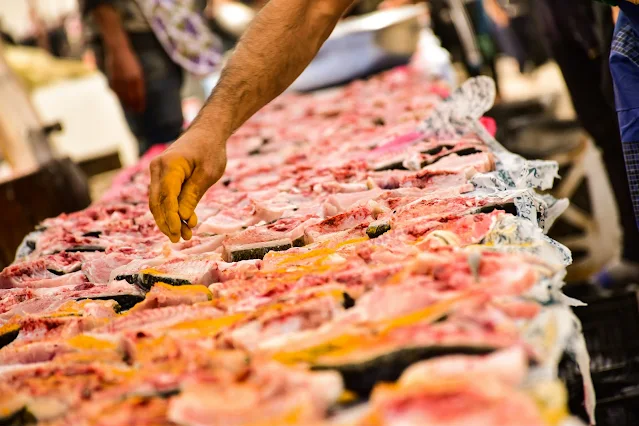1. The Hot Kitchen: The Heart of Production
The Hot Kitchen is where the magic happens — where raw ingredients transform into beautiful meals.
This area handles cooking processes such as boiling, grilling, frying, roasting, and steaming.
Mandatory Equipment for Hot Kitchen:
Why These Are Important:
High-heat, multi-batch cooking demands robust, durable machines.
Combi ovens allow flexible baking, roasting, and steaming — saving space and time.
Powerful exhaust systems maintain air quality and worker safety.
Which Businesses Need It:
Central Kitchens
Catering Operations
Hotels and Convention Centres
Cruise Ships
2. Butchery Section: Precision for Raw Meat Processing
The Butchery handles the reception, cutting, portioning, and prepping of all meats and seafood.
Mandatory Equipment for Butchery:
Why These Are Important:
Maintains hygiene standards by separating raw meat handling.
Reduces wastage with precise portioning.
Vacuum packing extends shelf life and ensures safe storage.
3. Cold Kitchen (Garde Manger): Freshness and Precision
The Cold Kitchen focuses on salad production, cold appetisers, sandwiches, and decorative platters.
Mandatory Equipment for Cold Kitchen:
Why These Are Important:
Preserves freshness, texture, and colour of food.
Provides hygienic preparation of cold-served items.
Blast chilling prevents bacterial growth.
4. Pastry and Bakery Section: Sweet Precision
No premium operation is complete without a Pastry & Bakery zone.
Mandatory Equipment for Pastry and Bakery:
Why These Are Important:
Bakery items require delicate temperature and humidity control.
Proper proofing ensures perfect breads, croissants, and pastries.
5. Dry Storage: The Pantry of Stability
Mandatory Features for Dry Storage:
Protects grains, flour, spices, and other non-perishables.
Prevents spoilage and maintains stock rotation.
Cold Storage Must Include:
Why These Are Important:
Maintains freshness and food safety standards.
Organized systems save space and energy.
7. Pot Wash Area: Cleanliness First
This often-overlooked zone is critical.
Mandatory Equipment for Pot Wash:
Why These Are Important:
Reduces labour and speeds up cleaning.
Ensures HACCP compliance by avoiding cross-contamination.
8. Critical Hygiene and HACCP Practices
Any modern kitchen must comply with HACCP (Hazard Analysis Critical Control Points) and maintain hygiene excellence:
Colour-coded chopping boards and utensils.
Regular temperature monitoring and recording.
Staff hygiene training programs.
High hygiene standards protect customers and safeguard the business.
Separate zones for raw and cooked food.
Handwashing stations with automatic soap dispensers.
9. Energy Efficiency and Waste Management
A sustainable kitchen saves money and the environment.
Suggestions:
Use Energy Star-rated appliances.
Implement recycling stations.
Monitor water usage and install low-flow faucets.
Design kitchen workflow to minimize electricity and gas consumption.
10. Fire Safety and Emergency Readiness
Essential safety measures include:
Fire Suppression Systems (ANSUL)
Emergency Exits Clearly Marked
Fire Extinguishers in Key Locations
Staff Fire Training Programs
First Aid Kits
Safety is non-negotiable when dealing with high-temperature equipment.
11. Staff Ergonomics and Comfort
Happy staff = better food and service.
A well-designed kitchen must focus on:
Anti-fatigue Mats
Adjustable Work Tables
Adequate Lighting
Air Conditioning
Clear Walkways
Reducing physical stress increases efficiency and reduces turnover.
12. Importance of Proper Kitchen Planning
Without smart kitchen planning:
Workflows clash.
Staff wastes time.
Hygiene risks increase.
Operational costs skyrocket. Good planning saves money, time, and reputation.
14. Why Professional Consultants are Important
Designing a kitchen without expert help is like building a house without an architect.
Professional restaurant and kitchen consultants:
Design efficient layouts.
Recommend cost-saving equipment.
Ensure hygiene compliance (ISO 22000, HACCP).
Train staff and create operational manuals.
Improve overall business profitability.
Conclusion
Building a high-standard, big-volume kitchen is not a luxury — it’s a necessity for any serious food operation.
From smart equipment choices to perfect kitchen flow, from hygiene practices to efficient waste management — everything matters.
If you aim to deliver excellence at every plate, start by building excellence behind the scenes — in your kitchen.











Comments
Post a Comment